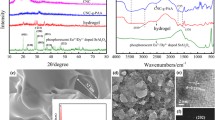Abstract
Cellulose hydrogels are biodegradable materials that can be applied as accommodating hosts for various species. Here we report the preparation of novel thin films based on luminescent cellulose hydrogels. The spectroscopic behavior of these soft materials and their sensing effects are investigated. Interestingly, we found that these films only give selective signal changes in the presence of Cu2+ in water in comparison with Na+, K+, Ag+, Mn2+, Co2+, Ca2+, Cd2+, Hg2+, Pd2+, Mg2+, Ni2+, Fe2+, and Fe3+. High visible-light transmittance and good flexibility for these films can be observed. More importantly, the thermal stability of rare-earth complexes could be significantly enhanced in aqueous solution as result of the protection by hydrogel matrix.










Similar content being viewed by others
References
Vogl O, Jaycox GD (1999) Polymer science in the 21 st century. Prog Polym Sci 24:3–6
Finkenstadt VL, Millane RP (1998) Crystal structure of Valonia cellulose Iβ. Macromolecules 31:7776–7783
Chandra R, Rustgi R (1998) Biodegradable polymers. Prog Polym Sci 23:1273–1335
Kuo YN, Hong J (2005) Investigation of solubility of microcrystalline cellulose in aqueous NaOH. Polym Adv Technol 16:425–428
Klemm D, Heublein B, Fink HP, Bohn A (2005) Cellulose: Fascinating biopolymer and sustainable raw material. Angew Chem Int Ed 44:3358–3394
Chang CY, Peng J, Zhang LN, Pang DW (2009) Strongly fluorescent hydrogels with quantum dots embedded in cellulose matrices. J Mater Chem 19:7771–7776
Swatloshi RP, Spear SK, Holbrey JD, Rogers RD (2002) Dissolution of cellose with ionic liquids. J Am Chem Soc 124:4974–4975
Murakami M, Kaneko Y, Kadokawa J (2007) Preparation of cellulose-polymerized ionic liquid composite by in-situ polymerization of polymerizable ionic liquid in cellulose-dissolving solution. Carbohyd Polym 69:378–381
Quang DT, Kim JS (2010) Chem Rev 110:6280–6301
Zheng YJ, Orbulescu J, Ji XJ, Andreopoulos FM, Pham SM, Leblanc RM (2003) Development of fluorescent film sensors for the detection of divalent copper. J Am Chem Soc 125:2680–2686
Bunzli J-CG (2010) Lanthanide luminescence for biomedical analyses and imaging. Chem Rev 110:2729–2755
Stich MIJ, Schaeferling M, Wolfbeis OS (2009) Multicolor fluorescent and permeation-selective microbeads enable simultaneous sensing of pH, oxygen, and temperature. Adv Mater 21:2216–2220
Montgomery CP, Murray BS, New EJ, Pal R, Parker D (2009) Cell-penetrating metal complex optical probes: Targeted and responsive systems based on lanthanide luminescence. Accounts Chem Res 42:925–937
Comby S, Gunnlaugsson T (2011) Luminescent lanthanide-functionalized gold nanoparticles: exploiting the interaction with bovine serum albumin for potential sensing applications. ACSNano 5:7184–7197
Tan CL, Wang QM, Zhang CC (2011) Optical and electrochemical responses of an anthrax biomarker based on single-walled carbon nanotubes covalently loaded with terbium complexes. Chem Commun 47:12521–12523
Tan CL, Wang QM (2011) Reversible terbium luminescent polyelectrolyte hydrogels for detection of H2PO -4 and HSO -4 in water. Inorg Chem 50:2953–2956
Nonat AM, Harte AJ, Senechal-David K, Leonard JP, Gunnlaugsson T (2009) Luminescent sensing and formation of mixed f–d metal ion complexes between a Eu(III)-cyclen-phen conjugate and Cu(II), Fe(II), and Co(II) in buffered aqueous solution. Dalton Trans 24:4703–4711
Orcutt KM, WS Jones, A McDonald, D Schrock, KJ Wallace (2010) A lanthanide-based chemosensor for bioavailable Fe3+ using a fluorescent siderophore: an assay displacement approach sensors. 10:1326–1337.
Tan CL, Zheng YH, Wang QM, Hang ZWG, Zheng SR, Cai SL (2011) Recognition of H2PO -4 and Cu2+ in water by luminescent terbium silica serogel. J Fluoresc 21:1117–1122
Wang QM, Tan CL (2011) Terbium hybrid particles with spherical shape as luminescent probe for detection of Cu2+ and Fe3+ in water. Anal Chim Acta 708:111–115
Blair S, Kataky R, Parker D (2002) Sol–gel-immobilised terbium complexes for luminescent sensing of dissolved oxygen by analysis of emission decay. New J Chem 26:530–535
Pagnot T, Audebert P, Tribillon G (2000) Photostability study of europium dibenzolymethide embedded in polystyrene thin films with high concentration. Chem Phys Lett 322:572–578
Acknowledgments
Q. M. appreciates National Natural Science Foundation of China (21002035) and Start fund of Guangdong Talents C10208.
Author information
Authors and Affiliations
Corresponding author
Electronic Supplementary Material
Below is the link to the electronic supplementary material.
ESM 1
(DOC 484 kb)
Rights and permissions
About this article
Cite this article
Tan, C., Wang, Q. Luminescent Cu2+ Probes Based on Rare-Earth (Eu3+ and Tb3+) Emissive Transparent Cellulose Hydrogels. J Fluoresc 22, 1581–1586 (2012). https://doi.org/10.1007/s10895-012-1098-1
Received:
Accepted:
Published:
Issue Date:
DOI: https://doi.org/10.1007/s10895-012-1098-1




